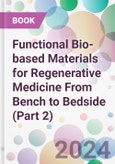Topics in the book include:
- the properties of bio-based materials, including biocompatibility, biodegradability, and the ability to mimic the native extracellular matrix.
- fabrication techniques and approaches for functional bio-based material design with desired characteristics like mechanical strength and porosity to promote cellular attachment, proliferation, and differentiation
- the incorporation of bioactive molecules, such as growth factors, into bio-based materials to enhance their regenerative potential.
- strategies for the controlled release of molecules to create a favorable microenvironment for tissue regeneration.
- the challenges and considerations involved in scaling up the production of bio-based materials, ensuring their safety and efficacy, and obtaining regulatory approval for clinical use
Functional Bio-based Materials for Regenerative Medicine: From Bench to Bedside is a valuable reference for researchers in biomedical engineering, cell biology, and regenerative medicine who want to update their knowledge on current developments in the synthesis and application of functional biomaterials.
Table of Contents
Chapter 1 Recent Advancement on Polyamide Composites as An Alloplastic Alternative in 3D Printing for Craniofacial Reconstruction- Abdul Manaf Abdullah, Marzuki Omar and Dasmawati Mohamad
- Introduction of Biomaterials
- Polymeric Materials
- Polyamide
- Properties of Pa and Composites
- Physical Properties
- Mechanical Properties
- Biocompatibility Properties
- Conclusion
- Acknowledgements
- References
- Tamrin Nuge, Xiaoling Liu, Yogeswaran Lokanathan and Md Enamul Hoque
- In Vivo Use of Stent Biomaterials
- Cardiovascular Implants
- Issues in Biomaterials for Coronary Stenting
- Occlusive Thrombosis Induced by Stent Implant
- Stent Under-Expansion
- Malapposition Stent Thrombosis
- Stent Fracture
- Acute and Chronic Inflammation Stenting
- Challenges and Future Perspectives
- Acknowledgements
- References
- Introduction
- Tendon and Ligament
- Structure, Function, and Biomechanical Properties
- Tendon and Ligament Injuries and Repairs
- Cell Sheet Technology
- Principle of Cell Sheet Technology
- Cell Sheet for Tendon and Ligament Repair
- Challenges in Using Cell Sheets for Tendon and Ligament Repair
- Conclusion
- Acknowledgements
- References
- Wan Hafizi Wan Ishak and Ishak Ahmad
- Introduction
- Cellulose Nanocrystals
- Hydrogels
- Hydrogels for Biomedical Applications
- Drug Delivery Systems
- Crosslinking of Hydrogels
- Chemical Crosslinking of Gelatin and Nanocellulose-Based Hydrogels
- Radiation Crosslinking of Gelatin and Nanocellulose-Based Hydrogels
- Concluding Remarks
- List of Abbreviations
- Acknowledgements
- References
- Renatha Jiffrin and Saiful Izwan Abd. Razak
- Introduction
- Electrospun Nanofibers
- Overview of Electrospun Nanofibers
- Important Features of the Electrospinning Process
- Electrospinning Parameters
- Electrospun Nanofiber for Drug Delivery
- Electrospun Nanofiber for Transdermal Drug Delivery
- Transdermal Delivery
- Transdermal Drug Delivery System
- Transdermal Delivery Using Electrospun Nanofibers
- Conclusion
- List of Abbreviations
- References
- Fan Ying Zhen, Hasan Subhi Azeez, Mohd Nor Ridzuan Abd Mutalib and Asma Abdullah Nurul
- Introduction
- Dental Disorders and Therapy Approaches
- Dental Tissue Engineering and Regeneration
- Bio-Based Materials for Dental Tissue Engineering
- Polysaccharide-Based Scaffolds
- Chitosan
- Cellulose
- Alginate
- Protein-Based Scaffolds
- Collagen
- Silk
- Gelatin
- Three-Dimensional (3D) and 4D Printing
- Conclusion and Perspective
- Consent for Publication
- Acknowledgements
- References
- Jun W. Heng, Ubashini Vijakumaran, Rohaina C. Man and Nadiah Sulaiman
- Scaffolds in Vascular Tissue Engineering Research
- Scaffold
- Synthetic Polymers
- Polyglycolic Acid (Pga)
- Polylactic Acid (Pla)
- Poly(Ε-Caprolactone) (Pcl)
- Natural Polymers
- Scaffold Cell Seeding Strategies
- Static Cell Seeding
- Dynamic Cell Seeding
- Magnetic and Electrostatic Cell Seeding
- Conclusion
- Conflict of Interest
- Acknowledgements
- References
- Osa Amila Hafiyyah, Anton Kusumo Widagdo, Ahmad Syaify and Retno Ardhani
- Chances and Challenges in Periodontitis Therapy
- Membranes in Periodontal Regenerative Therapy
- Bioactive Membrane Barrier
- Engineered Bio-Functional Barrier to Direct Periodontal Tissue
- Regeneration
- Conclusion
- References
- Mohamed Salih and Bakiah Shaharuddin
- Introduction
- The Burden of Corneal Blindness
- Anatomical Considerations for Corneal Tissue Engineering
- Corneal Epithelium
- Bowman’S Layer and Stroma
- Corneal Endothelium
- Corneal Wound Healing
- Requirements for Corneal Regenerative Strategies
- Biologically Active Molecules
- Exosome
- Small Molecules
- Rock Inhibitor
- Cellular Components
- Corneal Stem Cells
- Extra-Ocular Cells
- Mesenchymal Stem Cells (Msc)
- Scaffold-Free Cell Delivery
- Biomaterials for Corneal Tissue Regeneration
- Cellularised Scaffolds
- Polymers in Corneal Tissue Engineering
- Natural Scaffolds
- Conclusion
- Acknowledgements
- References
- Norazlina Mohamed
- Introduction
- Types of Biomaterials for Bone Scaffold
- Metallic Biomaterials
- Ceramic Materials
- Polymers
- Natural Products as Bone Scaffold for Bone Regeneration
- Bone Scaffolds as Delivery System
- Challenges and the Future of Bone Tissue Engineering
- Conclusion
- References
- Kok-Lun Pang, Sophia Ogechi Ekeuku and Kok-Yong Chin
- Introduction
- Structure and Metabolism of Bone
- Fracture Healing
- Characteristics of An Ideal Bone Scaffold
- Preparation of Natural Cancellous Trabecular Bone Scaffold
- Source of Bone Scaffold
- Decellularisation
- Demineralisation
- Assessment of Osteogenic Properties of Bone Scaffold in Vitro
- Implantation
- Conclusion
- Acknowledgements
- References
- Wan Kartini Binti Wan Abdul Khodir and Mohd Reusmaazran Bin Yusof
- Introduction
- Electrospinning
- Optimization of Electrospinning Parameter
- Biodegradable Polymeric as 3D Scaffold Materials
- Synthetic Polymer
- Natural Polymer
- Design of 3D Electrospun Nanofibers Based-Scaffolds for Tissue
- Engineering
- Characterization of 3D Nanofibers Scaffolds for Tissue
- Engineering Application
- 3D Electrospun Polymeric Nanofibers for Drug Delivery
- Design and Strategies of 3D Electrospun Polymeric Nanofibers
- Characterization of 3D Nanofibers Scaffold for Drug Delivery Application
Author
- Mohd Fauzi Mh Busra
- Daniel Law Jia Xian
- Yogeswaran Lokanathan
- Ruszymah Haji Idrus








